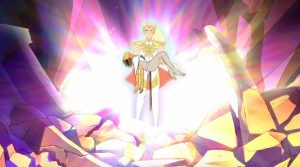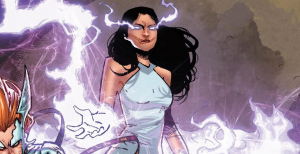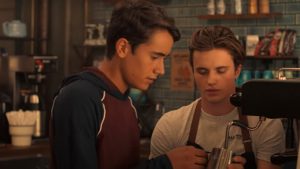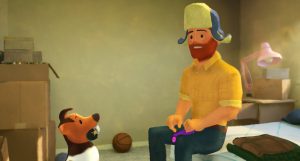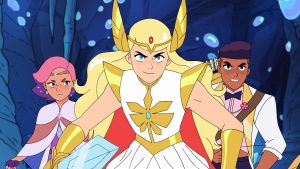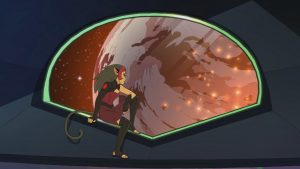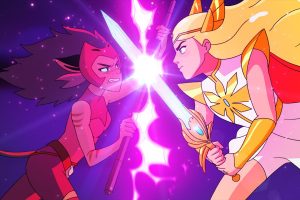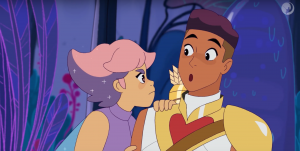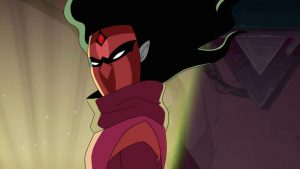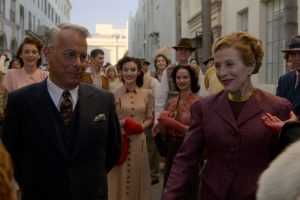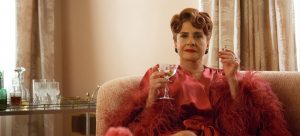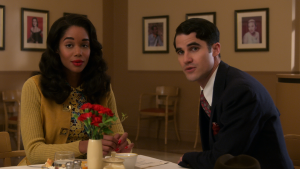SPOILERS FOR SHE-RA SEASON 5 AHEAD!

The animated She-Ra And The Princesses Of Power series on Netflix ended a few months ago, bringing five seasons to a close with one epic, super emotional finale. It was, in my opinion, a great conclusion: the fifth season raised the stakes higher than I would have ever thought possible, but still kept audiences firmly rooted in the emotional core of the whole series – the suspenseful will-they-won’t-they romance between heroine Adora (better known by her alias She-Ra) and the antiheroine Catra, which eventually ended with the two characters confessing their love for each other while the world came crumbling down around them. The power of that love was enough to activate the Heart of Etheria and in turn save the entire planet from being decimated by Horde Prime’s alien hordes; and so at last Adora, Catra, and their squad of friends and allies got to enjoy what seemed to be a mostly happy ending for everybody involved (well, except Horde Prime).
But it didn’t take long before the She-Ra fandom rallied behind a new hashtag on Twitter, #SheRaMovie, which has consistently become a top trend on social media for the past several weeks. And while some might dismiss it as dissatisfied fans hungry for more content, the truth is that there are many good reasons for why a She-Ra movie could and should happen: not only because it’s a smart business move to tap into such a large and clearly motivated audience, but because (a) there’s never been a better time for fan-driven campaigns and LGBTQ+ representation in animation, and (b) there are plenty more stories left to tell in the She-Ra universe.

Fan-driven campaigns have often been seen as foolish or vain endeavors: there have been times where they’ve succeeded in changing the minds of studio executives (Sonic the Hedgehog’s redesign, for instance), but 2020 has really made the sky the limit in terms of what a fan-driven campaign can achieve, and that’s all thanks to Zack Snyder’s never-before-seen cut of Justice League. Fans asked for it for years, and insisted that it would be better than the disastrous box-office flop that actually got released in theaters back in 2017; they trended #ReleaseTheSnyderCut whenever they could; and most importantly, they never gave up. They kept the movement going, they got support from the film’s cast and crew, they made the simple hashtag become a household phrase – and this year, they were rewarded for their efforts with the news that Warner Brothers will indeed soon release Zack Snyder’s Justice League. #SheRaMovie is in part inspired by the success of that movement, and as long as fans continue to make it trend regularly and continue to receive support from insiders (She-Ra showrunner Noelle Stevenson never fails to express her admiration for the fan campaign, which in turn motivates the fans to keep up their efforts), they will attract attention from the higher-ups at Dreamworks Animation and Netflix, and could soon share in the happiness that Snyder Cut supporters are feeling.
The need to see more strong LGBTQ+ representation in entertainment media is likely going to be another important factor in greenlighting a She-Ra movie. She-Ra And The Princesses Of Power was one of several animated shows and films this year that made a place in the narrative for well-rounded LGBTQ+ characters (and Noelle Stevenson’s wife Molly Ostertag is in fact responsible for writing several episodes of another of those shows, Disney Channel’s The Owl House, which features Disney’s first bisexual lead character) which earned the series plenty of well-deserved praise, including from my blog. With so much progress happening so quickly, my question for Dreamworks is…why stop now? When you have an established LGBTQ+ friendly franchise like She-Ra already perfectly positioned to continue leading the charge for diversity in animation, why not utilize that advantage?

And moving away from the business perspective for a minute, let’s take a look at in-universe reasons for why a She-Ra movie should happen: obviously, the movie needs to have a reason to exist. But luckily, She-Ra ends with plenty of set-up for an eventual spinoff – in fact, the very last scene features the entire main cast of characters already planning to embark on a new adventure to share their planet’s abundant magic with the rest of the galaxy. A spinoff movie could partly follow that plotline, which would take us to new locations and introduce us to new characters. Besides that, there are still several questions left unanswered after the finale, particularly questions about the First Ones and their forgotten technology, the origins of Horde Prime and of She-Ra herself, the universe outside Despondos, and the character of Madame Razz, who, despite not having and not needing a large role in season five, could be a major player in a She-Ra movie if her mysterious backstory ever gets explored in-depth.
Most of the characters have room to grow post-season five, no matter what else happens. Adora and Catra finally got together, but now both young women need to keep working to maintain the bond of trust and understanding they established after basically rebooting their entire relationship. They’re starting over from scratch, which makes their dynamic all the more fascinating. Glimmer, still Queen of Bright Moon, is going to have to return there eventually and rule alongside her best friend/boyfriend Bow and her recently-returned father, Micah, who was King before he went missing (I love some political intrigue). Scorpia and Perfuma will be rebuilding the Fright Zone side-by-side. Mermista and Seahawk should be commanding their own pirate fleet by now. Entrapta will be trying to convince her friends to trust Hordak, which won’t be easy considering he (checks notes) plundered and pillaged all of Etheria, robbed Scorpia of her birthright and brainwashed her into thinking she never had one, destroyed Mermista’s entire kingdom, kidnapped Adora and Catra as babies, employed Shadow Weaver to emotionally abuse his soldiers, personally tortured Catra, started a decades-long war with the Princess Alliance, paved the way for Horde Prime’s takeover, and never apologized for any of it. And the shape-shifter Double Trouble will be living their best life on a theater stage, even though we still don’t know what happened to their last disguise, the prophetic Prince Peekablue – in fact, finding him could be another potential subplot.

My ideal She-Ra movie would tackle all of these storylines, but, since the ending of season five perfectly sets up a space-based adventure, that’s where I’d want the film to start out, with Adora, Catra, Glimmer, Bow, Entrapta and Hordak (and Wrong Hordak, just for fun) either just setting off on a quest across the stars or returning from one. Most of the film, however, could still be set on Etheria. As for the conflict, with Horde Prime and Shadow Weaver both dead and Hordak a good guy now, who’s left to challenge She-Ra? Easy: the First Ones. The technologically-advanced, semi-mythological figures who created She-Ra and programmed Etheria to be their own superweapon may have been defeated during Horde Prime’s war of conquest, but it’s not implausible that some survived – and if some did, they’d want nothing more than to finally deactivate She-Ra, their experiment gone wrong. And they probably wouldn’t be too keen on the notion of Etheria spreading its magical resources across the galaxy, come to think of it. While Adora and Horde Prime had a fairly impersonal conflict, it would be hard to get more personal than a fight between Adora and the First Ones, who literally designed her super-sized avatar (well, Adora fighting Catra would be more personal, technically, but we’ve been there, done that).
To conclude, my message to all of you is to keep pushing for a movie because it could very well happen – but only if Dreamworks and Netflix both see that the demand is there. Don’t let a week go by where the hashtag doesn’t trend. Don’t stop calling for better, stronger LGBTQ+ representation in all media, but especially in animation where it’s currently on a roll. If you’re active in the She-Ra fandom, you know all this already, but it’s important to reiterate. Let’s make this movie happen!
How do you feel about a She-Ra movie? Do you think it’s smart from a business perspective, and do you think it’s wise to continue the story? Share your own thoughts, theories and opinions in the comments below!
